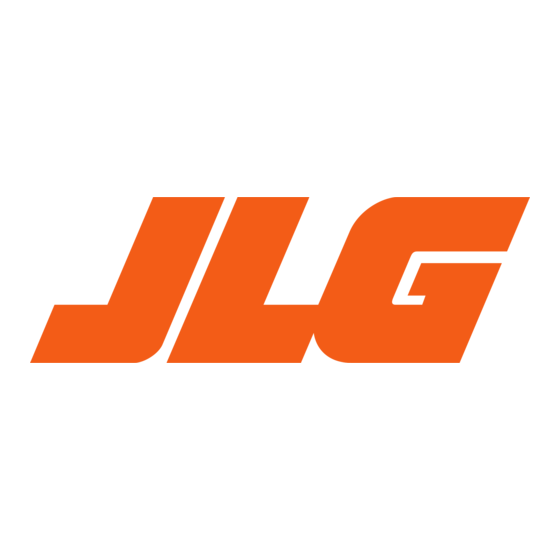
Table of Contents
Advertisement
Quick Links
OPERATORS & SAFETY
AUSTRALIAN OFFICE
JLG INDUSTRIES, INC.
P.O. Box 5119
11 Bolwarra Road
Port Macquarie, Australia
Telephone: 065 811111
Fax: 065 810122
Models
100HX
100HX+10
110HX
3120889
January 1, 1999
EUROPEAN OFFICE
JLG INDUSTRIES (EUROPE)
Kilmartin Place,
Tannochside Park
Uddingston, Scotland, G71 5PH
Telephone: 01698 811005
Main Fax: 01698 811055
Parts Fax: 01698 811455
CORPORATE OFFICE
JLG INDUSTRIES, INC.
1 JLG Drive
McConnellsburg, PA.
17233-9533
USA
Telephone: (717) 485-5161
Fax: (717) 485-6417
Courtesy of Crane.Market
Advertisement
Table of Contents

Summarization of Contents
FOREWORD
REVISION LOG
Records changes and updates to the manual.
SECTION 1 - SAFETY PRECAUTIONS
1.1 GENERAL
Manual's purpose, reading and understanding.
1.2 DRIVING/TOWING
Familiarity with drive, steer, stopping characteristics.
1.3 ELECTROCUTION HAZARD
Maintaining clearance from electrically charged conductors.
1.4 PRE-OPERATIONAL
Reading manual, authorized personnel operation.
1.5 DRIVING
Operator responsibility, safe driving practices.
1.6 OPERATION
Checking travel path, grades, platform use.
1.7 TOWING AND HAULING
Procedures for towing and hauling.
SECTION 2 - PREPARATION AND INSPECTION
2.1 GENERAL
Information for operation readiness, prior use checks.
2.2 PREPARATION FOR USE
Initial inspection, hydraulic leaks, security checks.
2.3 DELIVERY AND FREQUENT INSPECTION
Periodic inspections by dealer, checklist for defects.
2.4 DAILY WALK-AROUND INSPECTION
Operator responsibility for daily checks.
2.5 DAILY FUNCTIONAL CHECK
Checking load management, axles, and all functions.
2.6 TORQUE REQUIREMENTS
Torque chart details, bolt diameter, grade.
2.7 BATTERY MAINTENANCE
Battery terminal cleaning, cable connections.
SECTION 3 - USER RESPONSIBILITIES AND MACHINE CONTROL
3.1 GENERAL
Manufacturer's lack of control, user responsibility.
3.2 PERSONNEL TRAINING
Importance of authorized, qualified operators.
3.3 OPERATING CHARACTERISTICS AND LIMITATIONS
Understanding machine capabilities and restrictions.
Capacities
Criteria for raising boom/extending with load.
Stability
Machine stability on firm, level surfaces.
3.4 CONTROLS AND INDICATORS
Understanding controls and indicators for operation.
Precision Control Governor
Engine speed control for functions.
Ground Controls
Controls at ground station, safety warnings.
Platform Station
Controls and indicators on the platform console.
3.5 PLACARDS AND DECALS
Understanding and maintaining safety labels.
SECTION 4 - MACHINE OPERATION
4.1 DESCRIPTION
Overview of the aerial work platform and its purpose.
4.2 GENERAL
Procedures for starting, stopping, traveling, etc.
4.3 ENGINE OPERATION
Starting and shutting down the engine.
4.4 TRAVELING (DRIVING)
Safe driving practices, grades, and obstructions.
4.5 STEERING
Steering left/right, boom position.
4.6 PARKING AND STOWING
Procedures for parking and securing the machine.
4.7 PLATFORM
Loading from ground and above, level adjustment.
Platform Rotation
Rotating platform left/right.
4.8 AXLES, EXTENDING AND RETRACTING
Procedures for extending and retracting axles.
4.9 BOOM
Raising, lowering, telescoping boom, warnings.
Swinging the Boom
Engaging turntable lock, swinging direction.
Raising and Lowering the Main Boom
Using LIFT control to raise/lower.
Telescoping the Main Boom
Using TELESCOPE control to extend/retract.
4.10 SHUT DOWN AND PARK
Procedures for shutting down and parking the machine.
4.11 TIE DOWN AND LIFTING
Securing machine for transport, lifting points.
4.12 STEER/TOW SELECTOR (IF EQUIPPED)
Selector valve for steering or towing.
4.13 TOWING (IF EQUIPPED)
Procedures for towing the machine.
SECTION 5 - OPTIONAL EQUIPMENT
5.1 ROTATOR
Platform rotation feature.
5.2 DUAL FUEL SYSTEM (GAS ENGINE ONLY)
Switching between gasoline and LP gas.
5.3 TOW PACKAGE
Equipment for moving machine without drive/steer.
5.4 TRAVEL ALARM
Audible alarm for travel mode.
5.5 TILT ALARM
Warning for machine tilt and cutting out drive.
5.6 FOAM FILLED TIRES
Tires filled with foam to prevent flats.
5.7 ROTATING BEACON
Amber/red beacon for visual warning.
5.8 CYLINDER BELLOWS
Protective bellows for cylinder rods.
5.9 BOOM WIPERS
Neoprene strips to wipe boom sections.
5.10 HOSTILE ENVIRONMENT PACKAGE
Protection against dust, dirt, sand.
5.11 MOTION ALARM
Alarm for platform controls and footswitch use.
5.12 DESERT ENVIRONMENT PACKAGE
Protection for extreme hot, dry conditions.
5.13 110 VOLT/60HZ GENERATOR
110V generator for platform receptacles.
5.14 220 VOLT RECEPTACLE
220V receptacle to eliminate extension cords.
5.15 SPARK ARRESTOR MUFFLER
Muffler to contain engine sparks.
5.16 110 VOLT RECEPTACLE
110V receptacle to eliminate extension cords.
SECTION 6 - EMERGENCY PROCEDURES
6.1 GENERAL
Procedures for emergency situations.
6.2 EMERGENCY TOWING PROCEDURES
Procedures for moving machine during emergencies.
6.3 EMERGENCY CONTROLS AND THEIR LOCATIONS
Location of emergency stop switches and ground controls.
Auxiliary Power
Using auxiliary pump for operations.
6.4 EMERGENCY OPERATION
Using ground controls in emergencies.
Operator Unable to Control Machine
Actions when platform operator is incapacitated.
Platform or Boom Caught Overhead
Procedures when platform/boom is jammed.
Righting a Tipped Machine
Methods for righting a tipped machine.
Post Incident Inspection and Repair
Inspecting and repairing after an incident.
6.5 INCIDENT NOTIFICATION
Notifying JLG Industries of incidents.















Need help?
Do you have a question about the 110HX and is the answer not in the manual?
Questions and answers